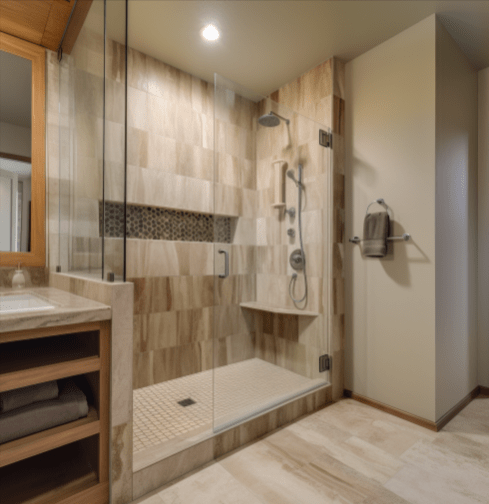As we age, the layout and safety features of our homes, particularly our bathrooms, become increasingly important. Bathrooms are often the site of falls and injuries among the elderly, making their design and safety features crucial. If you’re considering making modifications to your shower for safety reasons, you’re in the right place. This article will delve into the comparison between shower doors and shower curtains, discussing their pros and cons, and providing recommendations to help you make an informed decision about your shower layout.
Understanding Shower Doors: Pros and Cons
Shower doors, typically made of professionally installed, tempered glass, are a popular choice among many seniors. They slide back and forth to block water flow and provide privacy during a shower. But when it comes to safety, what are the advantages and disadvantages of having shower doors?

Pros
- Sturdy: Once professionally installed, shower doors provide a stable structure that lasts for many years.
- Easy to clean: Tempered glass can be easily wiped down and sanitized.
- Effectively blocks water: A properly sealed shower door keeps water in the shower and off the floor, helping to prevent slips and falls during transfers out of the shower.
- Keeps steam in: If you enjoy hot showers, shower doors can help keep the shower warmer for longer by trapping in the hot air.
- Fall barrier: A door can act as a barrier, preventing falls for someone who loses their balance towards the outside of the shower.
Cons
- Expensive: Shower doors tend to be more costly than shower curtains, both in terms of the product itself and the cost of professional installation.
- Hard to clean for hard water users: If you live in a hard water area or do not own a water softener, removing stains from a glass shower door can be challenging.
- A barrier for some equipment: Shower doors may pose difficulties if you’re using adaptive equipment such as benches, 3-in-1 commodes, or wheelchairs.
- Barriers to personal assistance: If you have a home health aide or caregiver assisting you with a shower, shower doors may be hard to work around.
Understanding these pros and cons can help you decide if a shower door is the right choice for your bathroom.
Understanding Shower Curtains: Pros and Cons
Shower curtains are a common choice for many, offering a blend of functionality and style. But when it comes to safety and convenience for seniors, how do they measure up? Let’s take a closer look at the pros and cons of shower curtains.
Pros
- Cost-effective: Shower curtains are generally less expensive than shower doors, making them a budget-friendly choice.
- Easy to install: You don’t need a professional to install a shower curtain. They’re typically hung on rings attached to a pole.
- Variety of designs: Shower curtains come in hundreds of designs, allowing you to customize the look of your bathroom.
- Easy to work around: Shower curtains can be easily moved aside, making them more accommodating for equipment and personal aide needs.
Cons
- Not a good support during a fall: If you lose your balance and grab a shower curtain, it’s likely to come down with you, offering little to no support.
- Can be difficult to clean: Many people find it easier to replace the plastic lining of a shower curtain rather than clean it.
- Can catch on the pole: For seniors with limited arm range or strength, a shower curtain can sometimes catch on the pole and fail to cover the entire shower, allowing water to spill out.
- Potential for tangling: Changes in water temperature can cause shower curtains to blow into the shower and get tangled around the user, which can be a fall hazard.
How Shower Doors and Curtains Work with Bath Safety Equipment
The choice between a shower door and a curtain isn’t just about personal preference. It’s also important to consider how each option works with various bath safety equipment. This can depend on several factors, including whether the shower is a walk-in shower or a tub-shower combination.
For instance, a shower door can be an effective tool for a walk-in shower but a significant barrier for a shower-tub combination. On the other hand, a shower curtain can be excellent for both a walk-in and a combination, but the risk of water spillage needs to be assessed based on the shower threshold or tub ledge.
Additional Safety Considerations in the Bathroom
Beyond the choice between shower doors and curtains, there are other safety considerations to keep in mind. For instance, non-slip mats can provide extra traction and reduce the risk of slipping, both inside and outside the shower. Grab bars can offer support and stability, helping to prevent falls. Shower seats can provide a comfortable and safe place to sit during a shower, reducing the risk of fatigue and slips. Handheld showerheads can make it easier to wash, particularly if you’re seated during your shower. Regular maintenance and cleaning of these features are also crucial to ensure they continue to provide safety benefits.
Making the Right Choice for You
Ultimately, the decision between a shower door and a curtain should be based on your individual needs, the layout of your shower, and any advice from healthcare professionals. Both options have their pros and cons, and what works best for one person might not work as well for another.
For example, a shower door can be an effective tool for a walk-in shower but a significant barrier for a shower-tub combination. Conversely, a shower curtain can be excellent for both a walk-in and a combination, but the risk of water spillage needs to be assessed based on the shower threshold or tub ledge.
FAQs
Before wrapping up, let’s address some common questions that seniors often have about making showers safer and more accessible:
- What type of shower is safest for seniors, a walk-in shower or a tub-shower combination? Walk-in showers are generally considered safer and more accessible for seniors, especially those with mobility issues. They eliminate the need to step over a high tub edge, reducing the risk of falls. However, it’s important to consider individual needs and preferences.
- Can I add a door to my existing tub to make it safer? Yes, it’s possible to add a door to an existing tub. This can make it easier to get in and out of the tub, reducing the risk of slips and falls. However, it’s important to consider the cost and the potential need for professional installation.
- How can I make my shower safer if I prefer shower curtains? If you prefer shower curtains, there are still plenty of ways to enhance safety. Consider using non-slip mats both inside and outside the shower, installing grab bars for extra support, and using a shower chair or bench if standing for long periods is difficult. Regular cleaning to prevent mold and mildew is also important.
- What other modifications can make a shower safer for seniors? In addition to choosing between a shower door and a curtain, consider adding safety features like non-slip mats, grab bars, a shower seat, and a handheld showerhead. Regular maintenance and cleaning are also crucial for safety.
Remember, the goal is to create a bathroom environment that is safe, comfortable, and meets your individual needs.

Colby Armstrong
Colby Armstrong, born and raised in Vermont, is an inventive designer who developed a fascination for interior design and color coordination from a young age, influenced by his home decorator parents. An ardent hiker and nature enthusiast, Armstrong draws inspiration from natural elements and colors, incorporating them into his unique shower curtain designs.

